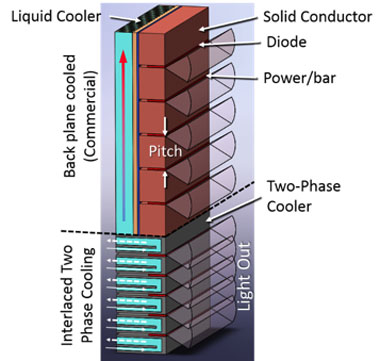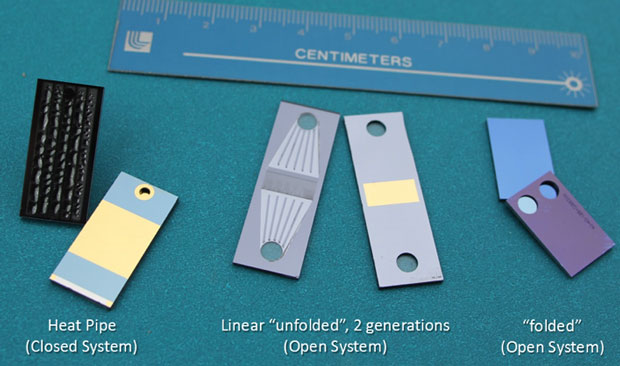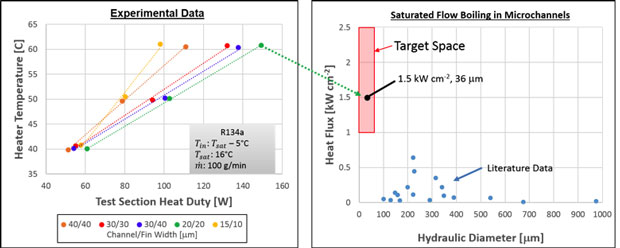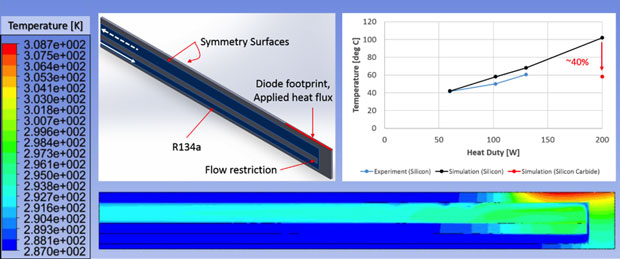Jack Kotovsky (14-ERD-040)
Abstract
Semiconductor laser diodes are the preferred light pump source for high-power, efficient, laser systems. These devices produce a substantial amount of heat during normal operation that is proportional to the device output. Heat dissipation is the primary limitation that impedes brighter laser systems today. To alleviate this issue, we intend to allow a coolant to boil in small passages that are in close proximity to the diode. While flow-boiling research has been studied in the research community, the conditions required for this application had not been explored, namely very high heat flux and channel dimensions of less than 100 μm. In this project, silicon microchannel heat sinks were produced. Collaborators at Colorado State University (CSU) characterized the performance of these devices in a custom-fabricated test facility. The working fluids were water and refrigerant 134a (R134a). During the initial experiments, improvements were realized that allow for a brightness of 1.9 times more than state-of-the-art diode coolers. The data were used to generate empirical correlations and validate computational fluid dynamics models. Then, utilizing experience and these models, a second-generation cooler was produced which was shown to increase brightness potential by a factor of 2.8. However, these data were all collected from a test structure that facilitated experimental characterization, but was not suitable for diode attachment because the diodes would obstruct the emitted light. A third-generation cooler, which featured a U-turn in the flow path to avoid blocking light, was designed and produced. This project has demonstrated that two-phase cooling can have a substantial benefit on laser system brightness.
Background and Research Objectives
Semiconductor laser diodes are the preferred light source to pump laser gain media due to their narrow emission spectra and high brightness (the ratio of light power to diode pitch, see Figure 1). Generally, continuous-wave, diode-pumped laser systems are more powerful and more efficient than the viable alternatives. The fundamental limitation for increasing the brightness of state-of-the-art laser diode systems is the removal of heat from the diodes to the cooling fluid while maintaining a precise diode temperature. Historically, heatsinks for these devices were designed such that the heat transfer fluid (coolant) remained at least 1 mm from the diode’s light-emitting facet and in a liquid state; no boiling was permitted to occur. A performance datum (brightness and diode bar temperature) was established from a survey of commercial products and demonstrated units from the research community. This revealed that the work of Skidmore, et al.1 at Livermore yielded the brightest continuous-wave diode system (1.49 kW cm-2 per bar at a pitch of 1.7 mm), and used single-phase liquid cooling. In this design and most existing alternatives, the diodes are mounted to a heat spreader that is subsequently cooled by a cold plate, otherwise known as back-plane cooling. Alternatively, this project proposed a fluid path that was interlaced with the diodes to minimize conduction lengths and reduce the temperature differential required to dissipate heat from the diode (Figure 1). This is imperative as the diode temperature must be fixed and, ideally, uniform because the emitted wavelength changes 0.3 nm for every 1 K change in temperature. Because the space between the diodes is very small, flowing adequate single-phase coolant through channels embedded in between each diode will require a substantial amount of pressure drop. In contrast, absorbing heat with a liquid–vapor phase change fluid can enable much lower flow rates. This is due to the latent heat of vaporization dominating the specific heat for any given fluid. Furthermore, the isothermal nature of phase-change cooling is superior to liquid-phase cooling because the latter requires an increase in fluid temperature as it absorbs heat from the diode. While the understanding of two-phase flow in microchannels has drastically improved over the past decade, the conditions required for cooling a diode (magnitude of heat duty and passage size) have not been investigated prior to this study.
Scientific Approach and Accomplishments
To facilitate the creation of higher brightness semiconductor diode arrays, a coupled modeling and experimental approach was utilized. The modeling effort includes finite-element analysis accounting for fluid-solid interactions by applying appropriate boundary conditions, computational fluid dynamics analysis using a homogeneous mixture flow model and an empirical correlation, which fits the coefficients of a heuristic model to experimental data. Since the anticipated heat duty and geometric scale had not been demonstrated in published literature, a custom-fabricated test facility was required to collect relevant data to generate and create these models. Due to subject matter expertise in the design and testing of phase-change thermal management systems, the Livermore team established a collaboration with professor Todd Bandhauer at Colorado State University (CSU). In a cooperative design-and-analysis process, Livermore developed and produced microstructured coolers, and CSU researchers experimentally characterized device performance.
A preliminary investigation of conceptual designs led to the determination that an axially grooved heat exchanger was the best choice to balance anticipated performance, pressure drop, control, and manufacturability. During this project, numerous iterations of rectangular microchannel array parts were produced and categorized as an open or closed system (heat pipe). Both concepts included an array of microscale channels etched into silicon with a hydraulic diameter less than 100 μm and had a glass substrate bonded to the top to facilitate visualization, shown in Figure 2. For the open system, to simplify heat transfer characterization, we produced a linear or unfolded design that had ports on both sides of the channel array. The final, and representative, design is characterized instead by a U-turn in the flow path between the diodes (Figure 1), allowing the fluid to enter and exit from the backside of the diode, which ensures that the emitted light is unobscured. Similarly, for the heat pipe, the phase-change fluid circulates in the cooler and the secondary cooling occurs behind the light-emission plane. For all of these devices, a range of microchannel dimensions were produced and tested. Also, a witness device of each was destructively characterized to determine as-built dimensions.
Heat-transfer performance was characterized in a custom test facility (Figure 3). The working fluids used were water and refrigerant R134a; however, the bulk of testing was performed with R134a due to its advantageous thermophysical properties for this application. The facility allows independent control of fluid flow rate, pressure, temperature, and heat duty at the test section. This is made possible by a pair of heat exchangers (upstream and downstream of the test section), chiller, gear pump, accumulation tank, and associated control systems. To quantify these parameters, a Coriolis flow meter measures the mass flow rate of the working fluid directly, an infrared pyrometer measures surface temperature, and thermocouples and pressure transducers are located along the flow path. Additionally, a digital microscope is used to visualize the transition from single phase to boiling along the test section. A systematic variation in test conditions enabled trends to emerge in the operation space. Figure 4 illustrates an overview of one such variation: heater temperature as a function of heat duty and channel/fin dimensions. The best performance was realized with 20-µm wide fins and channels at a depth of 200 µm, where a base heat flux of 1.49 kW cm-2 was rejected. For comparison, this exceeds the brightness of Skidmore et al.1 by a factor of 2.8, due to the drastic reduction in pitch at a similar power and temperature. This directly demonstrated that performance of laser systems could be improved substantially by allowing the coolant to boil in a microstructured heat sink, as reported in an M.S. thesis by Bevis at CSU.2
To further increase performance, an empirical correlation and computational fluid dynamics models were generated in parallel. To generate the empirical model, a finite-element analysis model was used to estimate the heat-transfer coefficient achieved during the experiment. This model accounted for heat spreading, which results from small length scales. Once compiled, the correlation fit experimental data to ±14%, and was used as a first estimate for untested conditions. To more rigorously predict the effect of geometry, flow path, and fluid selection, a computational fluid dynamics model was generated. This is a multiphase flow model using a homogeneous mixture approach, which is applicable when the phases move at the same velocity by assuming a local equilibrium over short spatial length scales. As shown in Figure 5, a half-channel-symmetry solid model was utilized to predict heat rejection, temperature, and pressure conditions. The model results compared well to tested conditions, especially in terms of measured surface temperature profiles along the silicon microchannel array. This validation afforded confidence in the model and thus enabled quantified predictions of modifications to the diode cooler, which accomplished a prime objective of the project.
Using the models, the geometric dimensions and heat sink material were explored to reveal an improved microchannel design for future studies. The first iteration of linear test sections resulted in a performance improvement of a factor of 1.9 in brightness over Skidmore et al.,1 which increased to a factor of 2.8 after redesign.3 These results demonstrated that there is significant potential for two-phase cooling in terms of generating a brighter diode array. Therefore, for a constant power requirement, fewer diodes are required and the array can be smaller. Alternatively, for constant area, this allows for an increase in power into the gain medium. Using these models, we explored alternative fluids and demonstrated that it is likely for ammonia to substantially enhance heat rejection. In a similar exploration, alternative heat-sink materials (copper tungsten, diamond, and silicon carbide) were compared to silicon. From a combined performance and manufacturing standpoint, silicon carbide is an excellent alternative. We predicted that the diode temperature could be reduced by 40% for a constant heat duty, due to the increased thermal conductivity (~490 W m-1 K-1 vs. 149 W m-1 K-1 for silicon). Finally, these models facilitated the transition from a linear flow path to the representative folded design (far right in Figure 2), which was fabricated but not characterized. These parts will enable coolant to flow to many coolers in parallel and simultaneously exhaust the two-phase effluent, as required in an ultimate diode stack.
Impact on Mission
This work supports the Laboratory's core competency in lasers and optical science and technology. Phase-change cooling is of direct relevance to many Laboratory missions and programs, including high-energy lasers to manipulate materials and generate radiation. This research has demonstrated that flow boiling could improve the laser diode array brightness by at least 2.8 times by rejecting a higher heat duty from thinner cooling structures while maintaining a precise operating temperature. This increased capability for heat rejection could lead to enhanced performance in directed-energy applications for national- and global-security missions. Such applications include laser peening, laser-assisted deposition, additive manufacturing, and generation of radiation for detection of nuclear materials.
Conclusion
It has been shown that two-phase cooling has the potential to drastically improve laser diode array brightness. Boiling a coolant that interlaces between diodes can reject a compelling heat duty while reducing both diode pitch and required coolant mass. In addition, flow boiling promotes greater wavelength uniformity, by maintaining more uniform diode temperatures. While an increase in brightness of 2.8 times was demonstrated in the current project, it is predicted that even greater capacity is possible. By either migrating the heat sink material to silicon carbide, or changing the working fluid to ammonia, we expect a further increase in laser system brightness. While the cumulative effect on the required size, weight, and power has yet to be quantified, we anticipate this technique will outperform current single-phase cooling strategies, which could have a sweeping effect on many programs and applications of laser systems at Livermore and in industry.
The team has submitted a full patent application (IL-12788) covering this cooling method and hired a graduate student (Bevis) from Prof. Bandhauer’s research group at CSU. The team has had positive interactions with potential commercialization partners and outside sponsors, so the work will be continued. Areas for further research include pursuing silicon carbide as the heatsink material and exploring additional fluids and other diode mechanical-joining methods to reduce stress at the heatsink/diode interface. Finally, a full assessment of the impact on size, weight, and power for using liquid–vapor phase-change processes are indicated to clearly demonstrate the advantages to potential external sponsors and technology adopters.
References
- Skidmore, J. A., et al., "Silicon monolithic microchannel-cooled laser diode array," Appl. Phys. Lett. 77, 10 (2000). LLNL-JC-138639.
- Bevis, T. A., “High heat flux phase change thermal management of laser diode arrays.” M.S. Thesis, Colorado State University (2016).
- Bandhauer, T. M., and T. A. Bevis, "High heat flux boiling heat transfer for laser diode arrays." Proc. Intl. Conf. Nanochannels, Microchannels, and Minichannels, ASME, Washington, DC (2016). LLNL-PRES-827630.
Publications and Presentations
- Bandhauer, T. M., and T. A. Bevis, "High heat flux boiling heat transfer for laser diode arrays." Proc. Intl. Conf. Nanochannels, Microchannels, and Minichannels, ASME, Washington, DC (2016). LLNL-PRES-827630.










